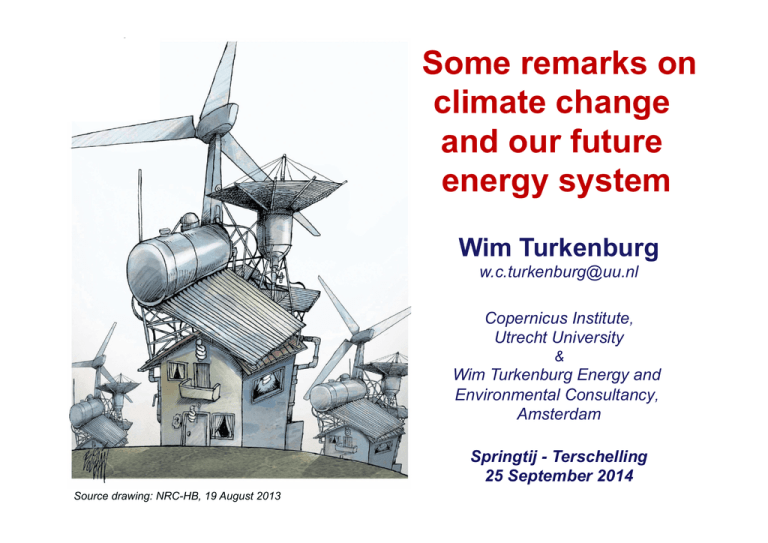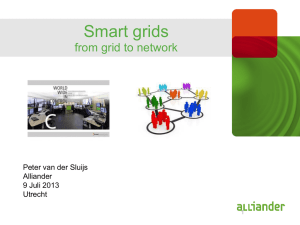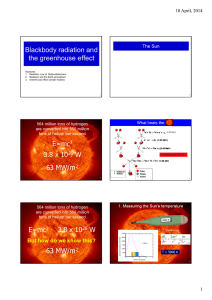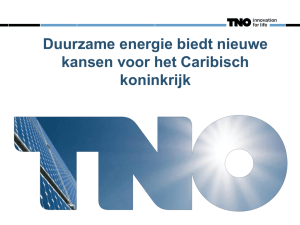Wim Turkenburg - Springtij Forum 2014
advertisement

Some remarks on climate change and our future energy system Wim Turkenburg w.c.turkenburg@uu.nl Copernicus Institute, Utrecht University & Wim Turkenburg Energy and Environmental Consultancy, Amsterdam Springtij - Terschelling 25 September 2014 Source drawing: NRC-HB, 19 August 2013 1 Climate Change 2 Monthly average CO2 concentration in the atmosphere at Mauna Loa Observatory, in the period 1958 – August 2014 Note: - In 2010 the emission of CO2 was ~37GtCO2 and the emission of all GHG’s together ~49 GtCO2-eq. - In 2010 the concentration of CO2 was ~388 ppm and of all GHG’s together ~444 ppm CO2-eq . - In 2010 the concentration of all GHG’s including cooling aerosols was ~403 ppm CO2-eq . (Source: IPCC, 2013 & EEA, 2013). 400 ppm Source curve: http://www.esrl.noaa.gov/gmd/webdata/ccgg/trends/co2_data_mlo.pdf (visited: 24 Sept. 2014) 3 Energy balance of the Earth Numbers are in Watts per square meter (W/m2) of Earth's surface - The atmosphere is transparent for most of the short-wave radiation from the sun, but it absorbs the long-wave radiation emitted by the Earth surface. - Radiative Forcing (W/m2) is defined as the change in atmospheric back radiation compared to the preindustrial equilibrium. Source: Kiehl and Trenberth, 1997 4 Indicatoren van een veranderend klimaat (IPCC, 2013) (a) gemiddelde sneeuwoppervlak op het noordelijk halfrond in maart-april, (b) gemiddelde zeeijsoppervlak in het Noordpoolgebied in juli-augustus-september, (c) verandering in de mondiaal gemiddelde hoeveelheid warmte in de bovenste laag van de oceaan (0-700m), ten opzichte van het gemiddelde van alle datasets voor 1971, (d) mondiaal gemiddelde zeespiegel, afwijking ten opzichte van het 1900-1905 gemiddelde van de langstlopende dataset. Alle tijdseries (gekleurde lijnen corresponderen met verschillende datasets) tonen jaarlijkse waarden. Waar beschikbaar zijn de onzekerheden aangegeven met gekleurde banden. Bron: Rob van Dorland, in: ‘De Staat van het Klimaat 2014’, HIER Klimaatbureau, Utrecht, Juni 2014, 10-14. 5 Average global temperature change (relative to average value of 1961-1990) Question: Quite some people are saying: “we are noticing a stagnation in the warming-up of the earth”. True or False? Source: KNMI, De Bilt, 2012 6 Elsevier – 02-10-2013 Which heating? Welke opwarming? Klimaatpanel IPCC wordt met elk rapport ongeloofwaardiger. Zeker nu de temperatuur sinds 1998 niet meer stijgt. Door Simon Rozendaal Er is weer een nieuw rapport van het VNklimaatpanel IPCC. En opnieuw luidt de boodschap dat het zeer waarschijnlijk is dat de opwarming door de mens wordt veroorzaakt. Je moet maar durven. NRC-HB – 21 -09-2013 The disaster that didn’t come De ramp die niet kwam Door Karel Knip De modellen die het broeikaseffect voorspellen, hadden niet voorzien dat het op aarde al twaalf jaar niet meer warmer wordt. Alle waarschuwingen voor de rampen die klimaatverandering zal veroorzaken, zijn nog veel dubieuzer. (…) Klimaatverandering bestaat. Maar al die CO2 veroorzaakt tot nu toe geen overstromingen. Geen cyclonen. Geen woestijnvorming. Geen malaria. Geen voedseltekorten. Geen waterschaarste. En geen oorlog. Trouw – 21 sept. 2013 Aarde warmt minder snel Heating of the op dan gedacht Door Joep Engels earth less than expected De klimaatsceptici krijgen een beetje gelijk: de aarde warmt mogelijk iets minder snel op dan eerder voorspeld. Deze ontwikkeling is nieuwe brandstof voor de verhitte controverses over de noodzaak van urgente maatregelen om het klimaat te redden. De Volkskrant – 28 sept. 2013 Heating is inevitable Opwarming is onontkoombaar Het is nu vrijwel zeker: het komt door de mens. Die stoot zoveel broeikasgassen uit dat de aarde aan het opwarmen is. En die opwarming zet door, zelfs als vandaag alle uitstoot van CO2 stopt. Door Martijn van Calmthout en Maarten Keulemans De mens is de belangrijkste oorzaak van de opwarming van de aarde, zeker in de periode na 1950. Dit concludeert het VN panel IPCC met aan zekerheid grenzende waarschijnlijkheid in zijn 5de rapportage over klimaatverandering. Het rapport legt een vrijwel eenduidig verband tussen veranderingen in de atmosfeer, de oceanen en de ijsmassa’s enerzijds en de toenemende concentratie van CO2 en andere broeikasgassen in de lucht. 7 The greenhouse effect and Global Warming - two remarks 1. ‘Global Warming’ is not equivalent to ‘average temperature on earth (troposhere)’ ! because of mechanisms like: - storage of heat into the (deep) ocean; - heat used to warm land, to melt ice, etcetera 2. The greenhouse effect of gases like CO2, caused by molecular absorption of heat radiation, is a scientific fact – nevertheless quite some (sceptical) people are denying it. For a demonstration of the absorption of heat radiation bij CO2, see a 1-min. movie on YouTube: http://www.youtube.com/watch? v=Ot5n9m4whaw 8 Where is global warming going? Source: John Cook, ‘Where is global warming going?’, Skeptical Science, 20 April 2010. (Calculated from IPCC-AR4; data from the period 1993-2003) 9 Carbon budget, ‘stranded assets’ and CCS 10 Development of global CO2 emissions from energy and industrial sources to limit temp. change to below 2°C (prob. > 50%) - The GEA energy pathways toward a sustainable future - Source: Global Energy Assessment, 2012 11 Global Carbon budget compatible with limiting global warming to +2°C versus fossil fuel reserves Conventional and unconventional fossil fuel reserves of coal, oil, and gas and the global carbon budget compatible with scenarios limiting global mean warming to 2°C above pre-industrial temperatures (with a 66% probability). Source of Fossil Fuel reserves: IPCC, 2011 (figure 1.7). Source of Carbon budget: IPCC, 2013 and IPCC erratum, November 2013. Source figure: ECF, “Statement by leading climate and energy scientists”, 2013 12 Unburnable Carbon and Stranded Assets Carbon Tracker (2013): - - - The Carbon budget for a 2°C scenario would be around 565-886 GtCO2 to 2050. A precautionary approach would mean that only 20% of the total fossil fuel reserves of 2,860 GtCO2 can be burnt to 2050. As a result the global economy faces fossil fuel assets becoming stranded. Source: Carbon Tracker, ‘Unburnable Carbon 2013: Wasted capital and stranded assets’, 2013 Comments WCT: - Not the use of fossil fuels but the emission of CO2 is the problem! - Carbon Tracker, and groups like Urgenda in NL, don’t give enough attention to the potential of CCS, although CCS can have a large impact upon ‘unburnable carbon’ and ‘stranded fossil fuel assets’! - However, within about 20 years we can’t allow any new investments in unabated use of any fossil fuel (given ‘max +2°C), having huge consequences for Shell, Exxon, BP, Gasunie, EBN, RWE, E.ON, etc. 13 Energy scenarios & Renewables 14 World Primary Energy Supply in 2009 (using GEA substitution method to calculate contribution from renewables) Fossil fuels: - oil - gas - coal 167 EJ 106 EJ 139 EJ 412 EJ ( 78 % ) ____________________________________________________________________________________________________________ Renewables: - large hydro 30 EJ *) - traditional biomass 39 EJ - ‘new’ renewables 20 EJ *) 89 EJ ( 17 % ) Nuclear: 27 EJ ( 5%) 528 EJ ( 100 % ) (about 4%) ____________________________________________________________________________________________________________ ____________________________________________________________________________________________________________ Total: *) Assuming for hydro, wind, solar and geothermal electricity: 1 EJ(el) = 2.85 EJ savings on fossil fuels, and for solar and geothermal heat: 1 EJ(th) = 1.17 EJ savings on fossil fuels. Source: W.C. Turkenburg et al., ‘Renewable Energy’. In: Global Energy Assessment, 2012, chapter 11 15 World renewables-based power sector investments by type (2001-2012) and total generation by type (2012) Increase of investments in new renewables by a factor 100 within about 20 years)! Source: IEA, 2013 (based on: BNEF, 2013) 16 Global Market Overview – Power Markets - Renewable energy comprises more than 26% of global power generation capacity in 2012. - Almost 22% of global electricity was produced from renewable energy (with 16.5% from hydro). - Renewables accounted globally for just over half (51%) of the estimated 280 GW of new installed electric capacity in 2012 (and in Europe even 70%). - We are witnessing a revolution in the energy field! Source: REN21, ‘Renewables 2013 Global Status Report’, June 2013 17 IEA on Renewables: Market Analysis 2014 & Forecasts to 2020 - In 2013, renewable power capacity expanded at its fastest pace to date. - Renewable power generation continued to grow strongly, reaching almost 22% of the global mix, compared with 21% in 2012 and 18% in 2007. - Globally, renewable electricity generation is now on par with that of natural gas, which remained relatively stable in 2013. - Investment in new renewable power capacity topped USD 250 billion globally in 2013 and is likely to remain at high levels. - Nevertheless, policy and market risks are increasingly clouding the development picture. - As a result, renewable power capacity additions and investment are expected to level off through 2020. Source: IEA, “Medium-Term Renewable Energy Market Report 2014”, August 2014 18 Some recent energy scenario studies - Can we achieve a sustainable future? • Shell, 2013: ‘New LENS scenarios’ (Mountains and Oceans) - Global warming will continue up to at least +4°C NO ! - Contribution from renewables in 2050: 22%-31%. • GEA, 2012: ‘Toward a Sustainable Future’ - Many combinations of energy resources, end-use, and supply technologies that can simultaneously address the multiple sustainability challenges. - Contribution from renewables in 2050: 30%-75%. - Cumulative storage of CO2 in 2050: up to 250 GtCO2. YES ! • Ecofys and WWF, 2011: ‘The Energy Report’ YES ! - A fully sustainable system is possible by 2050. - Almost 100% of all energy carriers, all regions and all sectors of the global energy system can be renewable, by 2050. 19 How to deal with intermittent renewables (wind / solar-PV)? … and misunderstandings about P2G and re-utilization of CO2 20 Integrating renewables: Electricity production by solar PV, wind and conventional capacity in Germany, 21-17 May 2012 Source: Fraunhofer ISI, 2013 21 Integrating renewables: Spain’s (possible) load curve and supply in 2050, Week 27 (on an hourly basis; weather data from 2008) Calculation based on the PowerAce model Source: W. Eichhammer, June 2013 / Fraunhofer ISI, 2012 22 Integrating renewables: Effect on peak electricity prices Solar power reduces average trading prices on liquid wholesale markets (Merit Order Effect) Source: Wim Sinke, ECN, 2013 (based on EU PVTP GA 2012 and IZES, Germany, 2012) 23 “EU utilities to be negatively affected by low energy prices until 2020” “Low wholesale power prices will make Europe's utilities suffer, corroding their revenues until the end of the decade since increasing renewable production and low demand integrate” (Source: rating agency Moody, on 3 July 2014). - Europe's electricity generators have been pressurized by the development of renewable energy, which is causing overcapacity and eroding prices, while productive coal-fired power stations are obliged to shut down under European climate protection regulations. - Benchmark German wholesale electricity prices have decreased by more than 40 percent since spring 2011, when Japan's Fukushima nuclear reactor meltdown rose global energy prices. - Meanwhile, electricity demand has been reducing due to the euro zone crisis and enhancing energy efficiency. Source: Energy Market Price, 3 July 2014 Electricity - Germany - spot price baseload (EUR/MWh) Electricity - France - spot price baseload (EUR/MWh) Negative! Blue: Germany / Red: France NB: At the end of 2013, the total installed renewable capacity - mostly solar and onshore wind, in Germany, Spain, Britain, France, Italy and the Nordic region - augmented to 290,000 MW, an increase from 205,000 MW in 2009. 24 Interaction between renewable energy supply, conventional energy supply, and the demand side Figure shows: - Many options available to deal with flexible components (solar-PV & wind). - Power-to-Heat at present far more attractive than Power-toGas (P2G). - Power-to-Gas may become attractive at 80% contribution from flexible components. Source: Steering Committee of the Renewable Energy Platforms, Germany, 15 Oct. 2012 25 Surplus Electricity in 8 scenarios until 2050 Power sector will demand storage > 80% share of RE Source: Michael Sterner, ‘The impact of the next big thing: (Solar) energy storage’, OTH Regensburg, 2014 26 ’Utility in a box’ When and where distributed solar generation plus storage competes with traditional utility service Vision of Rocky Mountain Institute (Amory Lovins), CohnReznick Think Energy, and HOMER Energy (2014): - Distributed electricity generation, especially solar PV, is rapidly spreading and getting much cheaper. - Distributed electricity storage is doing the same, thanks largely to mass production of batteries for electric vehicles. - Together they can make the electric grid optional for many customers — without compromising reliability and increasingly at prices cheaper than utility retail electricity. - Equipped with a solar-plus-battery system, customers can take or leave traditional utility service with what amounts to a “utility in a box”. - The point at which solar-plus-battery systems reach grid parity is well within the 30-year planned economic life of central power plants and transmission infrastructure. Source: RMI et al., ‘The Economics of Grid Defection’, RMI, USA, 2014, 72 pp. 27 Power-to-Gas Energy storage by coupling electricity and gas networks Source: Michael Sterner, ‘The impact of the next big thing: (Solar) energy storage’, OTH Regensburg, 2014 28 Power-to-Gas (H2 / CH4) - From the perspective of climate change, the production of CH4 using H2 from solar/wind and captured CO2 from fossil fuel power plants can only be an option if it doesn’t result into an increase of CO2 concentration in the atmosphere. - Electrochemical production of H2 is very expensive: About 5-10€/kgH2. Also ~30% of the kWh-energy will be lost (but in practise at present ~50%). - Note: Captured CO2 from a coal plant would cost at present about 80$/tCO2. - There is a need to develop a H2 production technology with (much) lower energy losses and production costs. - An interesting approach might be: plasmolytic H2 production: step 1: CO from CO2 (CO2 → CO + ½ O2) step 2: water-gas shift reaction (CO + H2O → CO2 + H2) step 3: Separating H2 from CO2 and re-use CO2 in step 1 Source: Partly based on a discussion with Richard van de Sanden, DIFFER, NL, 7 January 2014. 29 Misunderstandings about re-utilization of CO2 - Re-utilization of captured CO2 from fossil fuel power plants is more and more promoted [see e.g.: Chemical Magazine; TV program ‘Labyrint’; Report Cie Meijer (Noord-Groningen); NWO and FOM research progr.; EDGaR progr., URGENDA, Springtij, etc.]. - But: From the perspective of climate change it can only be an option if the emission of CO2 to the air is reduced, and about 25-30 years from now completely avoided. (Thereafter CO2 emissions should be negative!) Consequently: - Re-utilization of fossil CO2 in horticultures: not a permanent solution when striving for zero GHG emissions. - Re-utilization of CO2: no problem when CO2 from biomass. - Re-utilization of fossil CO2: only in a circular approach! - Massive application of P2G (methanization of H2): only by air capture of CO2 (Am. Phys. Soc, 2011: costs are $600/tCO2). 30 Renewable energy in the Netherlands Present contribution about 4.5% Question: Are we ‘the dummy guy’ or ‘loser’ within the EU? 31 Contribution renewables to gross electricity consumption in NL (1990-2013) and in EU-28 (2012) Figure NL in 2012: about 10.5 percent mostly from biomass and wind Bron: CBS, July 2014 Average figure EU-28 in 2012: about 23.5 percent - 54.1% from hydro - 30.4% from wind - 10.5% from solar - 4.1% from biomass - 0.8% from geothermal - 0.1% from tide, wave, and ocean power NL Source: Eurostat, 2013 32 EU renewables shares of final energy, in 2005 and 2010, with targets for 2020 NL is at present (far) behind most other countries; it is uncertain whether the 2020 target will be reached. Source: REN21, ‘’Renewables 2012 – Global Status Report’, Paris, 2012, p. 66. Question: Is NL “the dummy guy” or “loser“ within the EU? Answer: No (see next slides). Also: 14% in 2020 would be a major achievement. 33 Renewable Energy in 2011 in EU countries (EU27) The colour table shows that, within the EU, the Netherlands is not a favourable country for using renewables, apart from wind energy Source: Wim Turkenburg Consultancy, 2013 (based on data from IRENA, 2013). 34 Bioenergy NL: ranks 6 in Europe and 11 globally - Global use of biomass in the heat, power and transport sectors increased 2-3% in 2012, to approx. 55 EJ/yr. - Biopower capacity was up 12%, to nearly 83 GW globally, with notable increase in some BRICS countries. - In 2012, around 350 TWh of electricity was generated worldwide (biopower). Source: REN21, June 2013 35 Wind power share of total electricity consumption in EU (7%) and member states in 2012 NL ranks 13 in EU Note: when looking at the installed wind capacity onshore per km2 : NL ranks 3, behind Germany (1) and Denmark (2) Source: EWEA, ‘Wind in Power, 2012 European statistics’, February 2013 Note: Concerning population density: NL ranks 2, behind Malta 36 Cumulative installed grid-connected solar-PV in EU and CC NL ranks 13 Note: at present (2014) steep growth in NL in installed PV capacity Source: JRC, ‘PV Status Report 2013’, Sept. 2013 37 Cumulative installed grid-connected solar-PV in NL Source: P.J. Segaar, 2014 – based on: CBS, 26 May 2014 Forecast for 2020: between 4 and 8 GigaWatt installed Source: Wim Sinke, ECN, 2014 38 Thanks! Wim Turkenburg w.c.turkenburg@uu.nl 39


